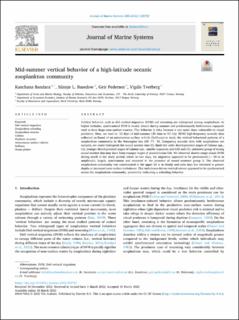Mid-summer vertical behavior of a high-latitude oceanic zooplankton community
Peer reviewed, Journal article
Published version
Permanent lenke
https://hdl.handle.net/11250/2999729Utgivelsesdato
2022Metadata
Vis full innførselSamlinger
- Articles [3011]
- Publikasjoner fra CRIStin [3061]
Sammendrag
Vertical behavior, such as diel vertical migration (DVM) and swarming are widespread among zooplankton. At higher latitudes, synchronized DVM is mostly absent during summer and predominantly herbivorous copepods tend to form large near-surface swarms. This behavior is risky because it can make them vulnerable to visual predators. Here, we used ca. 12 days of mid-summer (28 June to 10 July 2018) high-frequency acoustic data collected on board of an autonomous surface vehicle (Sailbuoy) to study the vertical behavioral patterns of a zooplankton community in the Norwegian Sea (69°–71° N). Comparing acoustic data with zooplankton net samples, we could distinguish the sound scatters into (1). lipid-rich older developmental stages of Calanus spp., (2). younger developmental stages of Calanus spp., smaller copepods and krill and (3). unknown group of strong sound scatters that may have been younger stages of planktivorous fish. We observed shorter-range classic DVM during much of the study period, where in two days, the migration appeared to be pronounced (> 50 m in amplitude), largely synchronous and occurred in the presence of sound scatterer group 3. The observed zooplankton community was concentrated in the upper 20 m in cloudy and calm days but retreated to greater depths at increased near-surface turbulence. This turbulence-driven vertical retreat appeared to be synchronized across the zooplankton community, potentially indicating a schooling behavior.
